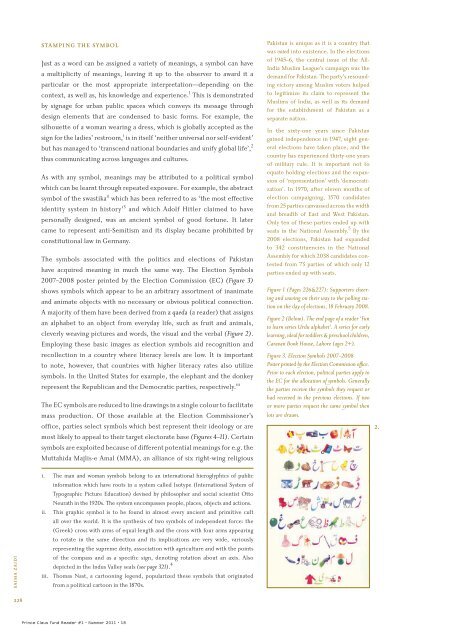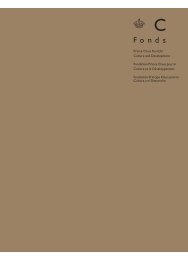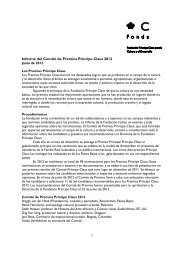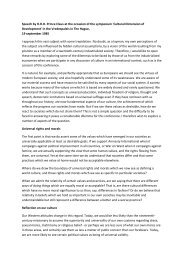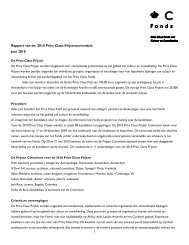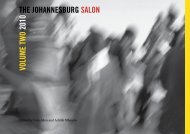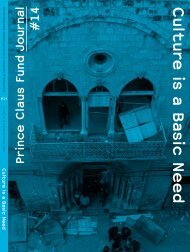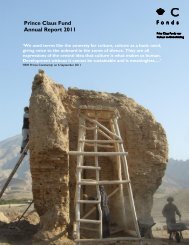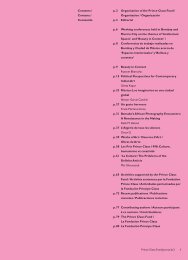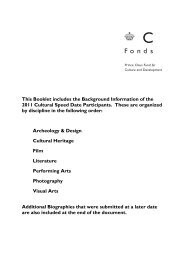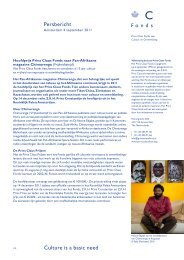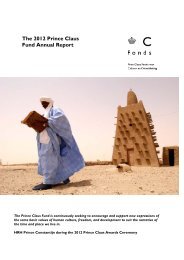3 summer 2011 - Prince Claus Fund
3 summer 2011 - Prince Claus Fund
3 summer 2011 - Prince Claus Fund
- No tags were found...
Create successful ePaper yourself
Turn your PDF publications into a flip-book with our unique Google optimized e-Paper software.
stamping the symbolJust as a word can be assigned a variety of meanings, a symbol can havea multiplicity of meanings, leaving it up to the observer to award it aparticular or the most appropriate interpretation—depending on thecontext, as well as, his knowledge and experience. 1 This is demonstratedby signage for urban public spaces which conveys its message throughdesign elements that are condensed to basic forms. For example, thesilhouette of a woman wearing a dress, which is globally accepted as thesign for the ladies’ restroom, i is in itself ‘neither universal nor self-evident’but has managed to ‘transcend national boundaries and unify global life’, 2thus communicating across languages and cultures.As with any symbol, meanings may be attributed to a political symbolwhich can be learnt through repeated exposure. For example, the abstractsymbol of the swastika ii which has been referred to as ‘the most effectiveidentity system in history’ 3 and which Adolf Hitler claimed to havepersonally designed, was an ancient symbol of good fortune. It latercame to represent anti-Semitism and its display became prohibited byconstitutional law in Germany.The symbols associated with the politics and elections of Pakistanhave acquired meaning in much the same way. The Election Symbols2007–2008 poster printed by the Election Commission (EC) (Figure 3)shows symbols which appear to be an arbitrary assortment of inanimateand animate objects with no necessary or obvious political connection.A majority of them have been derived from a qaeda (a reader) that assignsan alphabet to an object from everyday life, such as fruit and animals,cleverly weaving pictures and words, the visual and the verbal (Figure 2).Employing these basic images as election symbols aid recognition andrecollection in a country where literacy levels are low. It is importantto note, however, that countries with higher literacy rates also utilizesymbols. In the United States for example, the elephant and the donkeyrepresent the Republican and the Democratic parties, respectively. iiiThe EC symbols are reduced to line drawings in a single colour to facilitatemass production. Of those available at the Election Commissioner’soffice, parties select symbols which best represent their ideology or aremost likely to appeal to their target electorate base (Figures 4–11). Certainsymbols are exploited because of different potential meanings for e.g. theMuttahida Majlis-e Amal (MMA), an alliance of six right-wing religiousPakistan is unique as it is a country thatwas voted into existence. In the electionsof 1945–6, the central issue of the All-India Muslim League’s campaign was thedemand for Pakistan. The party’s resoundingvictory among Muslim voters helpedto legitimize its claim to represent theMuslims of India, as well as its demandfor the establishment of Pakistan as aseparate nation.In the sixty-one years since Pakistangained independence in 1947, eight generalelections have taken place, and thecountry has experienced thirty-one yearsof military rule. It is important not toequate holding elections and the expansionof ‘representation’ with ‘democratization’.In 1970, after eleven months ofelection campaigning, 1570 candidatesfrom 25 parties canvassed across the widthand breadth of East and West Pakistan.Only ten of these parties ended up withseats in the National Assembly. 5 By the2008 elections, Pakistan had expandedto 342 constituencies in the NationalAssembly for which 2038 candidates contestedfrom 73 parties of which only 12parties ended up with seats.Figure 1 (Pages 226&227): Supporters cheeringand waving on their way to the polling stationon the day of elections, 18 February 2008.Figure 2 (Below). The end page of a reader ‘Funto learn series Urdu alphabet’. A series for earlylearning, ideal for toddlers & preschool children,Caravan Book House, Lahore (ages 2+).Figure 3. Election Symbols 2007–2008Poster printed by the Election Commission office.Prior to each election, political parties apply tothe EC for the allocation of symbols. Generallythe parties receive the symbols they request orhad received in the previous elections. If twoor more parties request the same symbol thenlots are drawn.2.saima zaidi228i. The man and woman symbols belong to an international hieroglyphics of publicinformation which have roots in a system called Isotype (International System ofTypographic Picture Education) devised by philosopher and social scientist OttoNeurath in the 1920s. The system encompasses people, places, objects and actions.ii. This graphic symbol is to be found in almost every ancient and primitive cultall over the world. It is the synthesis of two symbols of independent force: the(Greek) cross with arms of equal length and the cross with four arms appearingto rotate in the same direction and its implications are very wide, variouslyrepresenting the supreme deity, association with agriculture and with the pointsof the compass and as a specific sign, denoting rotation about an axis. Alsodepicted in the Indus Valley seals (see page 321). 4iii. Thomas Nast, a cartooning legend, popularized these symbols that originatedfrom a political cartoon in the 1870s.<strong>Prince</strong> <strong>Claus</strong> <strong>Fund</strong> Reader #1 · Summer <strong>2011</strong> · 18


